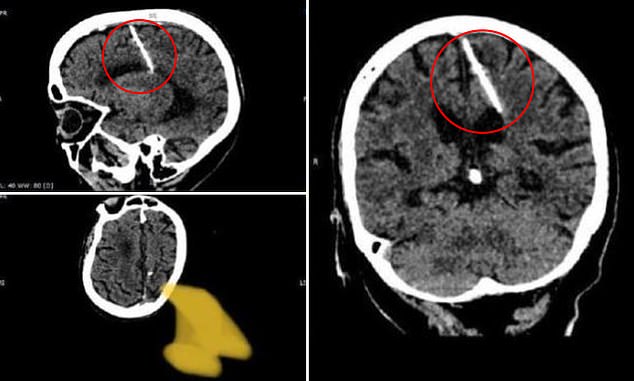Woman, 80, has lived her whole life without realizing she has a 3cm-long needle in her BRAIN – and the reason it’s there is horrifying
- The Russian woman survived her parents’ attempted infanticide during World War II
- Doctors happened to find a needle at the top of her brain during a CT scan
- READ MORE: Chinese woman has had a mysterious needle stuck in her head for 46 years
A Russian woman survived a fatal stab to the brain as a baby, leaving behind a 3-centimeter needle that doctors have just discovered.
The 80-year-old woman was the victim of a botched infanticide by her parents during World War II, when many families struggled to survive due to a lack of essential resources.
Doctors found the needle by chance when the woman underwent a CT scan of her brain for another unspecified reason.
They opted not to remove the needle because it did not cause the woman pain or other symptoms of a traumatic brain injury, adding that surgery could cause more problems.

The three-centimeter-long needle was inserted through the woman’s soft spot at the top of her head as a newborn. She was the victim of a botched infanticide allegedly committed by her parents during the World War II-induced famine in the Soviet Union
The needle inserted into her brain as a newborn entered through the soft spot at the top of her head called the fontanelle, where it lodged in her parietal lobe, the area responsible for processing sensory information and learning complex tasks such as mathematics.
The 80-year-old murder survivor is from Sakhalin, an island just north of Japan where about 461,000 people live.
Sakhalin Health Department said on the messaging app Telegram: ‘The needle penetrated her left parietal lobe, but did not have the intended effect: the girl survived.’
It is believed she was born in 1943, during the height of fighting on the war’s Eastern Front, when Russia – then the Soviet Union – repelled the German invasion to gain control of Stalingrad.
The Soviet Union was already in the midst of a prolonged famine that is estimated to have killed around 11 million people.
The situation was so dire that many families, knowing they would be unable to feed and care for their newborn children, resorted to killing them.
Sakhalin’s health ministry added: “Such cases during years of famine were not uncommon.”
The needle was inserted into the soft spot at the top of the newborn’s head. The fontanel at the top of a baby’s head is where the two frontal and two parietal lobes meet to form bony plates that are held together by strong fibrous tissue until the plates eventually join and grow together.
After what were intended as fatal stabs to the baby’s brain, the fontanel would quickly close, hiding the traces of the crime, and the baby would die.
Sakhalin health officials said: “The patient’s health is not at risk; her condition is being monitored by the attending physician.”
